Cord cutting. Long the refuge of the few, the proud. Those who would dare to take a stand against the arcane payment plans foisted upon the entertainment-starved masses by cable providers since time (warner?) immemorial. Why do I still need to purchase a "basic" subscription that contains channels I am guaranteed never to watch? In a world where I can customize my phone, my watch - even my food - why can I still not get the content I want when I want it?
Well, in these exciting times, there continue to be options for those who would cast off the shackles of our content-wielding oppressors. Naturally, there are streaming providers like Netflix, Hulu and Amazon, and there are ever more options for "premium" channels without a cable subscriptions (HBO and Showtime were first to the party, though the pricing model still leaves a lot to be desired). There are even pay TV providers like DISH providing their own cord-cutting option in services like SlingTV. It's almost getting to the point where you can select one from column A and one from column B, to satisfy your specific appetite for content. Almost.
As a long-time cord-cutter, I can attest to the fact that we are still far from having a perfect solution. The disparity of content and subscription models reek of an industry in upheaval; various conglomerates fighting for the most profits. And as good as streaming services have become, the inability to watch "live" broadcasts from majotr network TV channels can be frustrating. Even as "event TV" like the Super Bowl and the Academy Awards have started to provide streaming options, the experience (connection issues, tablet-only viewing) is far from ideal.
Lest we forget, a large portion of the content we want to see live (news, sports, prime-time) is still broadcast the old-fashioned way - the way our forefathers used to watch it: over the air. And now there are very solid options that allow you to capture over the air broadcasts in your very own DVR (provided of course, you have an antenna and reception). Tablo is one of those options, and one of the best we've seen.
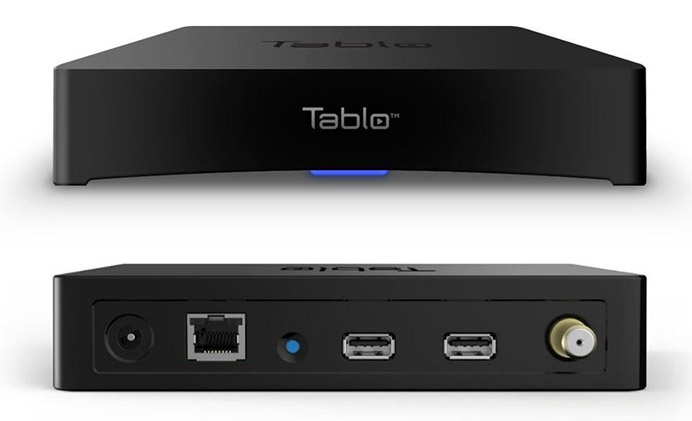
Over The Air, the Ultimate in Cord Cutting
In essence, Tablo - like simple.tv and other OTA devices - is a step back into the days when rabbit-ear antennas used to feed programming to our TVs. The Tablo device itself is a discreet, slick little black box that can be hidden anywhere. All it requires is a power cord, antenna (coax) connection (and antenna) and an external USB hard drive (to record your programming). You can connect to your home network via ethernet or WiFi (but more on that later).
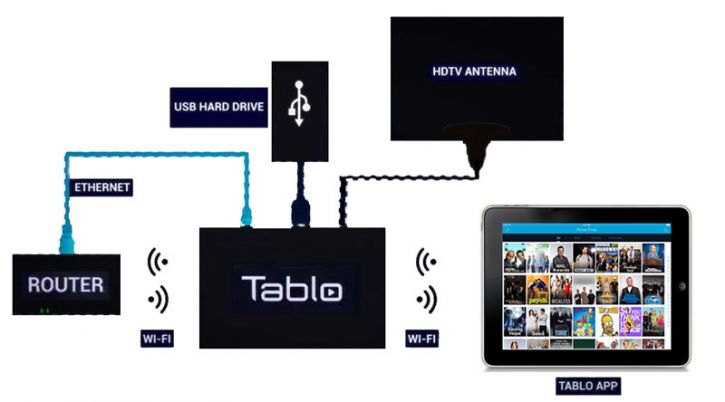
Yes, you read that right: Tablo is an OTA DVR box that connects to your network via WiFi. So you can keep the antenna and the Tablo box in a convenient location in your house (i.e., wherever you get the best over-the-air reception) and stream the content to your devices via WiFi. Of course, you'll also need a solid WiFi connection from the Tablo box to your router, and from the router out to your viewing devices in order to avoid lagging load times when you watch your content. But the Tablo's wired network port does allow a hard-wired connection if that's a possibility for you.
Go Configure
The setup couldn't be easier. You plug in the antenna, hard drive and power and turn it on. Then you connect to the device from a mobile app (Android or iOS) to do the configuration.
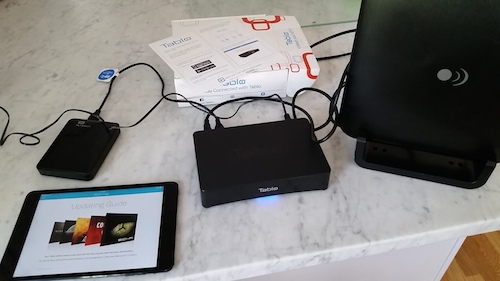
In a brilliant bit of config-fu, the app asks you to connect to your Tablo via the Tablo's own Wi-Fi network. When you run the app on your phone or tablet, the app brings up your Wi-Fi settings, which now show a new wifi network called Tablo_nnn (where nnn is some series of numbers). You connect your device to that network so that the app has direct access to the Tablo - smart! Then you do the config from there.

(Once you're connected to the Tablo, you tell the Tablo how to connect to your home WiFi network. After that's done, you don't need the Tablo_nnn network anymore. You can go back to using your usual home WiFi.)
After that's completed, you go through a series of config steps to setup your Tablo box. First, format the USB drive. A few notes here: (1) Tablo only accepts drives up to 2TB. Plenty of space, but don't think that your new Western Digital 4TB Passport drive is going to work (it won't be recognized). (2) The Tablo needs to format the drive to its own specs, so don't think you're going to keep anything else on that drive. It will be wiped. You should use a drive you can dedicate to the Tablo. A small price to pay, really.
Editor's Note: The company says that the 2TB drive limit has been lifted since firmware 2.2.2. Check this page for their recommendations on what drive to use with your Tablo DVR.
Next, you scan for local over-the-air channels. As part of the configuration process (or at any time via the Settings screen), the Tablo app offers a slick "Channel Scanning" utility that collects all the channels it can detect. It lists the broadcast resolutions (480p, 720p, etc), and it allows you to select the ones you'd like to have in your channel guide.
Hey, Cable providers, take a hint: we like to customize our channel guides!
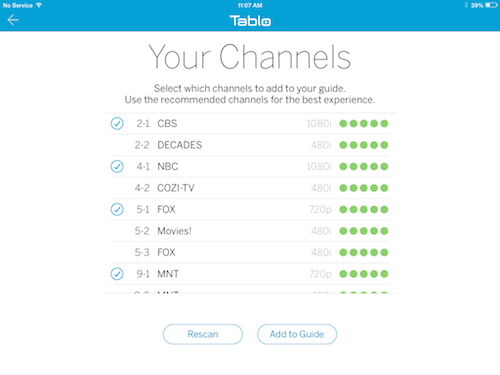
Testing, Channel 1-2-3
You're going to want to test out different locations for the antenna in your home - to see where you get the best reception and channel selection. Sites like tvfool.com and antennaweb.org can help you figure out what type of antenna to buy and where to point it, but sometimes multipath and reflections can cause reception problems. Also, if you're very close to the antennas and use a powered antenna with a built-in amplifier, you may actually get worse reception than with a passive antenna due to signal overload. So expeerimentation may be required.
Once you've placed the antenna where you think it should go, do the channel scan, move the antenna and try again. See if Tablo detects more channels than before (don't worry, it remembers the ones you already chose). Please note: Tablo will have trouble rescanning for channels if you skipped the hard drive formatting step (it needs the tuner to do the channel scan), so make sure you've taken care of the hard drive formatting first.
Once you're happy with your channel selection, it takes a while (say 10-15 minutes) for Tablo to download the guide information with channel and program listings. Don't worry, you can use the app for other functions, but be prepared for that wait.
(FYI, when you're done with that setup, Tablo will likely ask to do a Software update. It seems to ask for that on the first connection. It's quick and painless.)
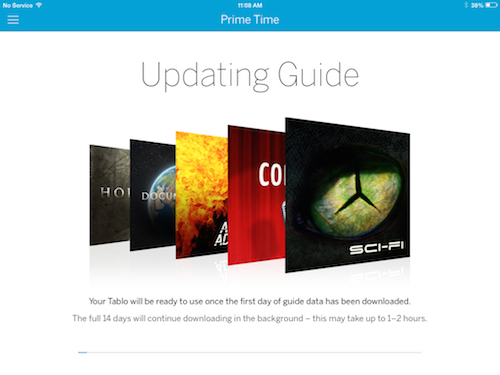
After the Tablo is setup, the channels are selected and the guide information is downloaded, you are ready to start watching Live TV over-the-air. You can watch live or recorded TV via the phone or tablet app, or you can also watch on your TV via a streaming media set-top box like the Roku, Chromecast, Apple TV, Android TV or Amazon Fire TV. I chose Roku as my delivery mechanism of choice.

If you're used to a standalone DVR from your cable or satellite provider that is plugged into your TV directly and has its own dedicated remote control, you may be in for a bit of a learning curve. On the Tablo, functions like changing the channel, pausing, rewinding and fast forwarding shows do have a bit of a lag compared to a directly connected, non-networked recorder. But then again, one Tablo recorder can provide streaming video and/or live TV broadcasts to multiple devices both inside and outside your home, which is something you can't do on most standalone pay TV boxes.

In terms of the various playback devices, the Tablo app interface on the iOS and Android platform is pretty slick, which makes the Roku interface a bit of a let down. It's a pretty simplistic set of boxes (Live TV, Recordings, Guide, etc), but it gets the job done. I can imagine a more exciting update in the future (a la Plex). The key functionality is very easy to find and use. I found myself using the mobile app to browse and scheduled recordings (I just found it quicker and easier), and used the Roku box connected to my projector for most of the actual viewing.
Roku seems to have a habit of playing the first two seconds of the show, reloading, and then playing the same bit again before continuing. I don't know if that's a Roku app glitch, or a function of my network speed, but it took a little getting used to.
When we brought this up with the Tablo folks, they mentioned that they did have a new version of the Roku channel in best test, which you can check out here. And that channel has since made it into production. We were able to install the beta version of the new Tablo channel for Roku, although getting full functionality required us to let Tablo support take remote control of our box temporarily, to debug and resolve some problems with the update. After we got things up and running, we found the new channel vastly superior to the previous production interface. Where the previous one had a blocky, utilitarian, "Playskool's my first app" feel, this new-and-improved version is a ground-up re-do. It fits in with must-have Roku apps like Netflix and Plex, and it fixes that pesky "two-second repeat" issue from the previous version.
Like all the other Tablo apps, the Roku channel benefits greatly from having a subscription to the guide data, since there is plenty of room for imagery. It's clearly still first-generation (no genres, no ability to sort recordings or shows!), but it's a great foundation. Looking forward to seeing the next updates from Tablo.
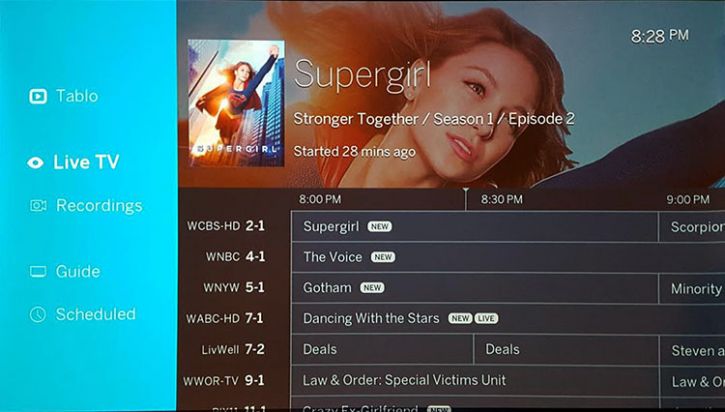
One note: when you're looking through the channel guide in the mobile apps and you see a show you like, if you want to watch it live, you have to click on the channel name, not the show. Clicking on the show gives you the show information. Clicking on the channel brings up to the live stream of that channel. I'm not sure why they didn't just add a play button to the show information page, but whatevs. Also, the Android app has a hard time keeping up with scrolling the live TV channel list, but that should be fixed in a later release.
A small but important feature: when you're watching one of your recordings and want to rewind or fast-forward, the Roku app shows you a thumbnail of the progress, which makes it very easy to skip commercial. This is critical to any cord-cutter's life. Thanks Tablo!
What a Reception!
From then on it's all about reception and resolution. You may find yourself moving your antenna around the house looking for the best location. Everything old is new again. It's like moving around those old rabbit ear antennas (for those of you the remember such a thing). In the 21st century version, you'll find yourself walking around with the antenna in one hand and the iPad in the other, watching live TV and checking the reception. Not bad for instant gratification. (Please note, while smacking old black-and-white tube TVs sometimes helped with reception, smacking your iPad is not recommended.)
You'll want to test a variety of content before you place the antenna in its final permanent location. For the real test, I'd recommend watching live sports (football or basketball, something with a lot of movement) in 1080i or 720p HD broadcasts. If your antenna can handle that, you're probably good. Once I got the antenna situated, I was amazed at the picture quality. Beautiful widescreen high definition resolution (from the channels that provided that) over-the-air from a Tablo box over my WiFi network. What a world.
Of course, not everything's free. Tablo needs to get paid somehow! The Tablo device itself is available in two flavors: a 2-Tuner ($219.99 MSRP) and 4-Tuner ($299 MSRP) model, for which you'll also need to purchase an antenna. Coming soon will be the Tablo Metro ($249 MSRP), which includes two integrated fractal digital TV antennas for urbanites living within 25 miles of broadcast antennas. All of these models require that you purchase an external hard drive and, yes, with the 4-tuner model you can record up to 4 shows at once, you addict you.
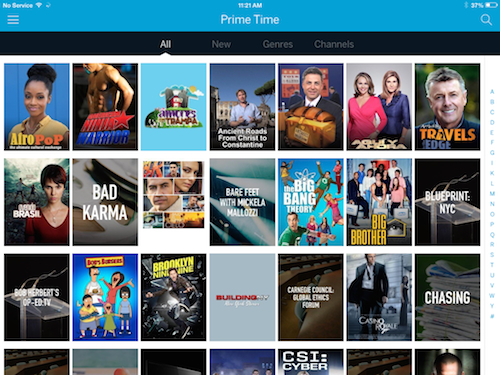
But that's not all. The real kicker is the subscription plan. For $4.99 per month, Tablo offers a subscription which allows you access to its channel guide data, series synopses and additional metadata that allows for various sorting functions within the app (i.e., sports, movies, TV). You get 30 days of the premium guide free when you setup your Tablo, which is enough to get you hooked. After that, the app seems positively hobbled since you can only see the current Live TV schedule in text format (along with your recordings, of course). So to schedule something for the future, you have to scroll until you find it rather than use the sorting features you've come to enjoy. Still, $4.99/month is a small price to pay for OTA HD glory with a robust guide. Or is it? That's for you to decide.
If you like what you see and expect to hold onto Tablo for a while you can also opt for a "lifetime" subscription to the Tablo guide service, for just $150. And "lifetime" for Tablo means the owner's lifetime, not the box itself. If your box breaks in a few years, you'll be able to transfer that lifetime guide subscription over to new hardware. With every provider (Hulu, Netflix, Spotify), as well as your ISP, looking for a monthly fee, the nickle-and-diming of the general public is getting a little ridiculous. But I digress. At least with Tablo, you can trade that perpetual monthly fee for a fairly reasonable one-time cost up front and still get all the benefits of a rich program guide and a nice selection of free content.
All in, for a 4-tuner Tablo DVR, a 2 Terabyte USB hard drive, a decent indoor or outdoor HD antenna and a pre-paid lifetime subscription to the Tablo guide, you're looking at a total cost of about $480 with no monthly fees. You can cut the up-front cost in half if you go with the 2-tuner Tablo DVR, a smaller HDD and pay for the guide from month to month instead. In either case you'll be saving big money over time if you eliminate your monthly cable bill.
Big Picture: Check; Big Sound: Not Quite
In terms of picture quality, there isn't much to complain about here. The Tablo box does re-encode the MPEG2 over the air digital broadcasts to the more efficient H.264 codec in order to take up less storage space on the hard drive and less bandwidth while streaming the content. Live and recorded broadcasts we watched were crisp and clean, with nice detail and richly saturated colors, even blown up to 100 inches on our 1080p JVC projector and screen. Picture artifacts were few and far between and mostly only happened with channels that were on the fringe of reception, or were lower bandwidth "bonus" channels that accompanied one of the main network feeds.
On the audio side, Tablo also re-encodes the broadcast audio stream from Dolby Digital (AC3) to two-channel AAC sound. This means you will lose the discrete 5.1-channel surround sound embedded in some over-the-air broadcasts. Tablo tells us they are considering an AC3/Dolby Digital 5.1 passthrough option as a future upgrade. This won't matter if you're using the TV's built-in speakers or a simple sound bar. But if you have your TV hooked up to a receiver and surround sound system, the best you'll get is matrixed (non-discrete) surround sound. Overall the sound was also quite enjoyable with clear dialog, music and effects. But we'd love to see a Dolby Digital passthrough mode as it would improve the immersiveness of the sound.
Turn-Ons:
For those of you who've never done it, watching free over-the-air TV via your own private DVR over your home WiFi network is a bit of a revelation. It will make you wish every cable channel was broadcast over-the-air so we could finally have the customization we crave without ridiculously high cable bills. Consider Tablo's networked Over the Air DVR a vision of things to come. In glorious high definition!
Where to Buy:
| Overall | |
|---|---|
| Value | |
| Performance | |
| Features/Ergonomics |